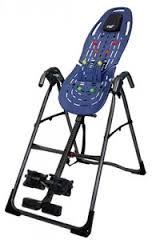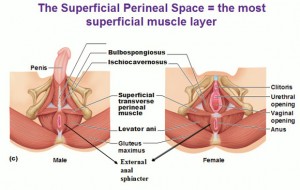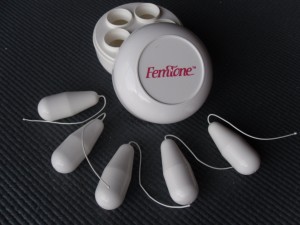Pelvic Floor Therapy
Pelvic Floor Muscles Respond to Therapy
Pelvic Floor Muscles respond well to home therapy. Childbirth, life long constipation, trauma, injury, abdominal surgeries, among other things, can contribute to weakened pelvic floor muscles. Damage to the pelvic floor contributes to urinary incontinence and can lead to pelvic organ prolapse. Prolapse occurs in women when pelvic organs (bladder, rectum, vagina or uterus) protrude into or outside of the vagina.
Pelvic Floor Therapy
Muscle Training Exercises
Pelvic floor muscle training exercises can help strengthen the muscles under the uterus, bladder, and bowel (large intestine). They can help both men and women who have problems with urine leakage or bowel control. Toning the muscles in that area may strengthen the muscles of the pelvic floor thus stabilizing the organs. Treat yourself naturally with the following easy to implement options.
Pelvic Floor Muscles
The Pelvic Floor
- Ischiocavernosus
- Bulbospongiosus
- Superior Transverse Perineal Muscle
- Urogential Diaphragm
- Anal Triangle: Levator Ani, External Sphinctor Ani, Anococcygeal Ligament
- Perineum: Symphysis Pubis, Ischial Tuberosity, Sacrotuberus Ligament and the Ischiopubic Ramus
- The Pelvic Diaphragm
- Levator Ani
- Levator Prostate/Vaginae
- Puborectalis
- Pubococcygeus
- Iliococcygeus
- Coccygeus
- Pelvic Wall: Obterator Internus, Piriformis, Sacrotuberus Ligament, Sacrospinous Ligament and the Tendinous Arch
Bowel Movements and Pelvic Floor Health
Position and Timing of Bowel Movements support Pelvic Floor Health. Low toilet seating with knees high. Use a stool for feet or move to a shorter toilet. Squatty Potty can help.This facilitates easier bowel movements. Work with gravity. Give yourself time daily, without rush, preferably in the morning. This creates space and gives your body permission to perform this essential function. This training can be started at any time of life and will assist you throughout the rest of your life. In this hectic world I am not surprised when folks tell me they are not giving themselves time in the morning to actually train their body to perform this essential function. The body is incredibly trainable.
 Inversion Table for Pelvic Floor Health
Inversion Table for Pelvic Floor Health
The Inversion Table, used gently and carefully with mindfulness, can be an important tool for improving Pelvic Floor Health. An inversion table is a valuable tool for creating space and time for the pelvic bowl to relax and not have pressure from weight, gravity and stress. Using an inversion table correctly is the key. We humans love to do everything to an extreme, and with this tool / resource it is best to start very slow. Using your table or a friends, set the height correctly for you, making sure the table is in a place that is safe ie: over a rug for starters and can move without hitting a wall or furniture. Most tables have guards and options for keeping the inversion slight. Do not invert to the maximum. This is a soft, easy, mindful, minimal invert. Once securely fastened on the inversion table bring yourself safely to a level spot. Slowly invert to five degrees. Stay there, utilizing the Elevator Exercise and the Fem Tone Weights while inverted. Five minutes or less is sufficient in the beginning. Once you get the hang of it and understand the idea and create that space and grace in your mind, then you can advance to 10 degrees and so on. Each inversion segment should include consciousness of visceral movement (feel your vital organs moving with the inversion), consciousness of your pelvic floor and pelvic bowl. Breathing deep and steady while contracting pelvic floor muscles is advantageous. Visualize the pelvic floor becoming stronger as you create space and reorganize structure. Here is a LINK to a SIMPLE VIDEO for beginner Inversion Table Use.
Pelvic Floor Therapy
 Pelvic Floor Self Massage
Pelvic Floor Self Massage
Pelvic Floor Self Massage can strengthen and tone pelvic floor muscles. This can create a stronger and stable pelvic floor and is worth a try! Begin Pelvic Floor Self Massage using surgical gloves to find tight and sore areas in and around the anus as well as the walls of the vagina and base of the penis. This can be done in the bath or lying down (not standing) Using fingers and thumb, locate tight sore areas. Place pressure on a painful trigger point and wait 8 to 12 seconds for it to release. Take a deep breath. You can tune into your body and feel tight sore areas release. This will facilitate blood flow in ischemic areas and allow the body to reorganize around the work. The body wants to be in alignment and it wants to work correctly. Damaged soft tissue can be retrained with self massage.
Male Pelvic Floor Therapy
Specific direction for self massage of Male Pelvic Floor
Locate the the Bulbospongiosus on the photo above. Using fingers and thumb locate painful tissue or overstretched tissue in that area. Apply pressure with one hand and stretch the penis out with the other. This work can be done around the entire base of the penis. This tones the fascia and will work to strengthen tissue and release painful trigger points creating blood flow and healing. If any area is too painful, move away, take rest and return applying less pressure.
Locate the Ischiocavernosis on the photo above to familiarize yourself with its location. Apply pressure to that area. Use your index finger or thumb or both. You will be able to locate different parts of that superficial muscle with either finger or thumb. Work around the underside of the penis. If anything is too tender, release and come back after a few breaths with less pressure.
Locate the Superficial Transverse Perineal Muscle on the photo above. Palpate for tight sore areas with finger or thumb and hold the trigger point for 8-12 seconds until you feel it release. If any points are too painful, move away and go back with less pressure. Work from the ischium to the perineal body. There will be tight places in all of the muscles surrounding the penis and the anus as well as the muscles in between.
Female Pelvic Floor Therapy
Specific direction for self massage of female pelvic floor
Locate the Bulbospongiosus on the diagram above. Placing surgical gloves on hands begin to massage the area, locating tight or sore areas, holding with breath, waiting for a release. There will be tight places or overstretched tissue in these areas that are ischemic. Self massage will create blood flow which will facilitate healing and strengthening of those muscles. Some points may be very painful. If so, move away, take breath, and come back with a lighter touch.
Locate Ischiocavernosis on the diagram above. Self massage this area by locating tight, sore, painful areas and holding them until they release. Usually a release can be felt within 8-12 seconds, taking two or three deep breaths. Work around the entire area paying close attention to strengthening the pelvic floor. Activation of these muscles through the Elevator Method can in location and perception.
Locate the Superficial Transverse Perineal Muscle in the diagram. Self massage this area paying close attention to the entire perineum. This area will respond to the trigger point release. It will become stronger through increased blood flow and attention.
Pelvic Floor Muscle Training Exercises
Pelvic Floor Exercises Strengthen and Tone Pelvic Floor Muscles
Pelvic Floor Exercises Strengthen and Tone Pelvic Floor Muscles. Elevator exercise discussed below, bridge pose, legs up a wall can be done using a block between the legs and focusing on the area that needs toning. The block can be squeezed between the inner thighs at the same time you practice the Elevator Method. Kegels are fine but they tend to be done in a contraction and relaxation sequence. The Elevator concept works much better. Instead of squeezing and letting go as in the Kegel Method, the Elevator Method is a continued contraction and squeezing as you imagine the pelvic floor rising, lifting and squeezing from Floor One to Floor 13. Rising, squeezing and lifting the pelvic floor, vaginal and anal muscles up, up up. This exercise can be done by itself, with the Fem Tone Vaginal Weights, lying down initially and then you can get adventurous and walk around exercising, toning and strengthening your pelvic floor. The Elevator Method can be performed while inverted. This can be exhausting so you are doing a GREAT job if you can practice this 3-5 minutes each day, increasing the time as you get stronger.
Incontinence
Do you suffer from incontinence? Here is a video by Shila Tirabassi, LMT, from the St. John Clark Pain Treatment Center discussing therapy that can alleviate incontinence. Finding a well trained Neurosomatic Massage Therapist to perform this protocol is highly advised.
Vaginal Weights
Fem Tone Vaginal Weights
Vaginal weights can be utilized to strengthen and tone the pelvic floor. These little weights shaped just like tampons are smooth with a string attached for safety. They can be inserted safely and used in small timed increments while squeezing the muscles of the vaginal cavity with the Elevator Method. Here is a link with more information regarding FemTone Vaginal weights.
Nutrition and Diet Soften Stools Decrease Transit Time
Losing weight will assist healing in the pelvic floor by lessening the work that the pelvic floor has to do to hold everything in.
Supplements to Support Pelvic Floor
Supplements to support Pelvic Floor are generally digestive supplements or overall body wellness supplements or Sexual support or Tissue Support supplements. You can start with sesame oil rubbed on the belly externally. Coconut oil works well too. This can be done with a small amount of oil rubbing the abdominal area gently in a clockwise (for toning) or a counterclockwise (for release) directions. Fish oil by mouth can create softer stools, as can ground flax seed. Magnesium by mouth is a good choice. Soaking in Magnesium Salt Bath (Epsom Salt Bath) is an excellent way to support pelvic floor health. You can research probiotics as an aid. Turmeric is an excellent digestive aid and anti inflammatory aid. Water, as much as you can drink, always assists and we have found that warm water with honey and /or warm teas also can be helpful. Triphala is an excellent tonifier and you can learn more about that digestive aid on your own, by referring to Dr. Frawley, Ayervedic Physician, or by checking back here to TreatYourselfNaturally.com for future articles on nutrition and supplementation.











Where can I get the best foam roller? Everything I see are too hard.
Hello Kalika! Good to hear from you. http://www.spri.com/product/eva-full-foam-roller/EVA-FR.html is a good source. There is also a list of sources on my site to the right side of the home page..power systems is another good source. They come in different densities so you may have to try them out at sports authority….Thanks again!
Jenny,
thank you so very much, for your generosity in sharing your wisdom.
You have blessed my life (and many through me) by sharing this info!
May it come back to you tenfold!
Dear Helen
Thank you. Please share with others. SO much pain can be alleviated by gently manipulating and focusing on the pelvic floor muscles. Try the video that leads one to manually manipulate your viscera (vital organs). It is rewarding and helpful.
My best
Jenny
Doing massage on husband ,having pain there and I like dissolved a hard or tight spot .. He said it feels like it moved up to middle of his right side . He is having a slight problem urinating. Have I done something wrong.
Hello Vel,
This answer is late in coming, but No, you did not do anything wrong. There are laws of the body that will send referrals in ‘other’ places.
Continue the work, carefully, and gently.
Good luck!
Jenny
Many thanks for helping people find the info they need. Good stuff as usual. Keep up the good work!!!
Hello Fitoru! Thanks a bunch. Be Well. Jenny
I am detoxing from heavy metals. I believe that I have toxic metals stored in my abdominal region. I have heard that if you have heavy metals or other toxins stored in your body, you can help get them out by massaging or having a massage therapist massage the area where the toxin is stored. Other types of massage, notably barefoot massage, have helped me before. I therefore would like to try pelvic floor massage to see whether it could also help me. Can you suggest a massage therapist? This type of massage is a little off the beaten track.
Hello Chris. Yes, massage can help detoxification of the body….I sent you an email. I can suggest a therapist, but need to know where you are located. Thanks a bunch. Jenny